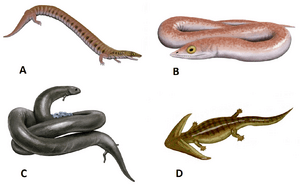Lepospondyl facts for kids
The Lepospondyli were a fascinating group of ancient animals. They were a type of tetrapod, which means they had four limbs. These creatures lived a very long time ago, during the Palaeozoic era. Scientists sometimes group them with other ancient amphibians called Labyrinthodonts.
Contents
What were Lepospondyli?
Lepospondyli were a diverse group of small, four-limbed animals. They lived from the Carboniferous period to the early Permian period. This was a time when Earth looked very different from today. These ancient creatures were never very big.
Where did they live?
These animals lived in different environments. Some were fully aquatic, meaning they lived only in water. Others were semi-aquatic, spending time both in water and on land. There were also some Lepospondyli that were completely terrestrial, living only on land.
What did they look like?
The Lepospondyli group included many different species. They had various appearances, some looking like modern newts. Others resembled eels or even snakes. Some species also looked a bit like lizards. Their varied forms helped them adapt to different ways of life.
Main Groups of Lepospondyli
Scientists have identified six main groups within the Lepospondyli. Each group had its own unique features. These groups help us understand the diversity of these ancient animals.
Acherontiscidae
This is one of the less common groups. They are known from very few fossils.
Adelospondyli
The Adelospondyli were a group of eel-like Lepospondyli. They had long, slender bodies and lived in water.
Aïstopoda
The Aïstopoda were very unusual. They were snake-like animals that had lost their limbs. They moved by wriggling their long bodies.
Lysorophia
Lysorophia were another group with long, slender bodies. They were also limbless or had very small limbs. They likely lived in water or burrowed in soft ground.
Microsauria
The Microsauria were a diverse group. Many of them looked like small lizards or newts. Some were aquatic, while others lived on land.
Nectridea
Nectridea were often aquatic or semi-aquatic. Some had very distinctive, flattened heads. A famous example is Diploceraspis, which had a boomerang-shaped head.
Images for kids
See also
 In Spanish: Lepospóndilos para niños
In Spanish: Lepospóndilos para niños











